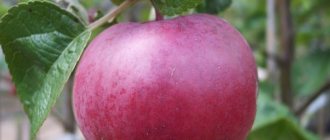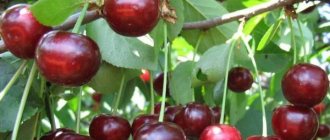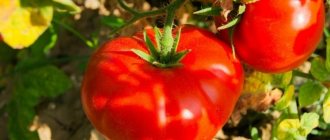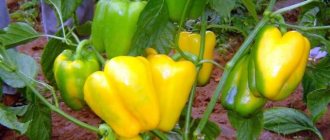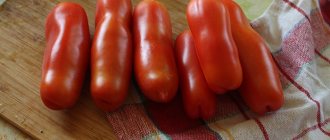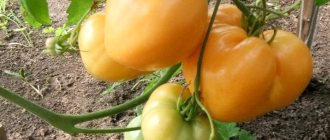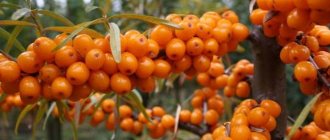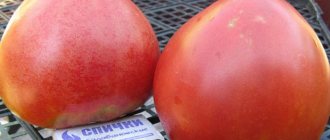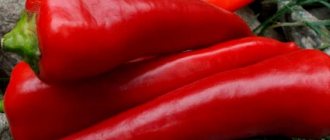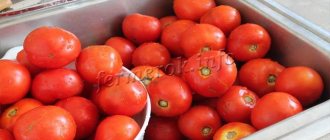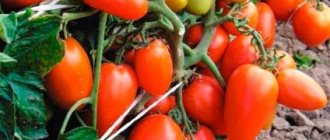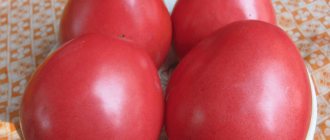Description, photo
Among the autumn species, the Yantar variety has been particularly popular in the Middle Urals for many years.
Important! In hot summers and warm, late, long autumns, it produces an earlier harvest, but with worse shelf life of the fruit. Due to this, it is classified as early autumn.
Obtained by P. A. Dibrov at the Sverdlovsk OSS by free pollination of Welsey and an unknown seedling.
Zoned;
- in the Urals;
- in Western Siberia;
- in the Volga-Vyatka region.
Although it has been criticized due to the small size of the apples, it is widespread among gardeners in the Urals and Siberia. True, in recent years, thanks to the emergence of new, high-quality winter-hardy hybrids, its cultivation has been noticeably reduced.
According to its characteristics , the tree is medium-sized, with a strong, sparse and spreading crown. The skeletal branches are sinuous, gray in color and extend from the main trunk mainly at an angle close to 90°. The upper branches are mostly directed upwards. Young seedlings have good branching.
The shoots are of the same color, but have a tint of brown. Elbow-shaped, long and thin. The leaf is green, but without shine. Oval in shape with a rounded base and a sharp tip. The petioles are saber-shaped and of different sizes. The flowers are medium in size, cup-shaped and white in color. The buds are light cream.
The apples are small-fruited. On structureless acidified soils (podzolic) they do not exceed 50 g. In well-fertilized chernozem soils they can reach 70 - 80 g . The shape of the fruit is blunt-ribbed, narrowed towards the base. The skin is smooth, yellow in color with a hint of natural amber. With a small funnel, compressed on both sides, and a thin stalk. The fruit's saucer is flat and has five tubercles.
Apple tree Yantar.
Description of the apple tree Amber Necklace
Apples begin to ripen in September. But, like many other varieties, these apples do not yet acquire their final taste at this time, which they acquire only after two months of storage. This apple tree has features that distinguish it from many other varieties - it has simply phenomenal resistance to low temperatures and excellent yield. It is successfully grown even in Western Siberia, collecting up to 20 kg of excellent fruits from each tree. And this despite the fact that the apple tree is not very tall; it is considered a semi-dwarf, and grows at most up to 2.5 m.
Like all columnar apple trees, the branches of this tree grow upward. The side branches are short, the trunk is thick. The leaves are bright green in color and have a characteristic gloss. The structure of the bark is smooth. The apple tree blooms with beautiful white saucer-shaped flowers. Bright yellow apples with an amber tint also look very beautiful. Apparently, this apple tree got its name thanks to the color of the apples.
This variety is self-sterile. This means that for its full pollination the presence of pollinator varieties is necessary nearby. Apples on this tree will begin to appear next year, but at this time it is better to remove the ovaries, because during this time the apple tree has not yet been able to properly grow stronger. But starting from the age of 3, the fruits can already be allowed to develop. At this time, the apple tree will already have enough strength to bear fruit. Harvesting from such an apple tree is not difficult, since the apples are evenly distributed on the tree.
additional characteristics
When ripe, apples stay on the branches quite well. Even removing a fruit from a branch is difficult and requires effort. They can be eaten straight from the tree as they do not require ripening.
Advantages and disadvantages
Pros:
- Good environmental adaptation;
- Decent harvest;
- High assessment of apple quality;
- High-quality processed products;
- Excellent transportability.
The main disadvantage is considered to be poor resistance to diseases such as scab.
Dimensions of an adult tree
Does not reach tall sizes and is considered medium height. Even with ideal soils and care, it does not exceed 4 m.
Productivity
One of the advantages is the regular and high yield of Amber. In successful years, an average of up to 175 kg of apples .
Tasting assessment
The fruit pulp is fine-grained, cream-colored, quite juicy, with good density. Fragrant, with very high taste and pleasant natural sourness. The tasting score is 4.85 – 4.95 points.
The fruits of the Yantar apple tree have a high tasting rating.
Winter hardiness
Frost resistance is very good. Not afraid of cold winds and frost. Easily tolerates early spring frosts. Quickly adapts to climatic conditions.
Disease resistance
According to gardeners, it has excellent resistance to various diseases . But during prolonged rains or in conditions of high humidity, it is often affected by scab . Preventative treatment for scab disease is required.
The Yantar apple tree is susceptible to scab.
You can learn how and what to fight scab from the video below:
Advantages and disadvantages of the variety
The main advantage of Red Amber is its fruiting in the second year after planting, early ripening of apples. And also a beautiful presentation of apples. The fruits are completely painted bright red when ripe, do not lose their presentation during transportation, and are stored in cool rooms for up to 2 months.
Apple trees tolerate dry summers well, withstand average frosts, and are not infected by scab and powdery mildew spores.
A disadvantage can be considered zoning for warm climates and intolerance to severe frosts.
The main advantage of Amber is its ability to adapt to various climatic conditions, from hot to sharply continental climates, in a short time. The variety is widely used to create new elite varieties of apples with unique properties.
Long shelf life of the crop – up to 5 months. Preservation of presentation during storage and transportation. Use as a raw material for the production of juices, jams, confiture, purees for baby food, dried fruits and other types of products with high taste.
Disadvantages are the possibility of trees becoming infected (in rainy summers) with scab and powdery mildew spores, a long period of non-fruiting when planting seedlings (they bear fruit for 6-7 years), late ripening of apples.
Reviews
Anatoly. “I bought two seedlings at a nursery (I was very attracted by the photo and description of the variety), and one was a gift from friends. Over the years, three trees produced a wonderful harvest of good-tasting apples. And only after 20 years the fruits began to overripe and scab appeared. Apparently, with age, strength is depleted.”
Basil. “I don’t grow apple trees myself, but my neighbors Yantar have two trees. We even have enough for two families, since they are small. I really like the taste. My wife is especially good at preparing compotes for the winter. I think that for the Moscow region, if there is insufficient time for care, this is one of the best options.”
Catherine. “The seedling planted in the early 2000s did not bear fruit until 9 years later, although the care and conditions seemed to be appropriate. Maybe there weren't enough pollinators in the area. They themselves do not have space to plant fruit trees; the area is too small. Since 2012 it has been bearing fruit well and consistently.”
Pros and cons of this variety
The crown of this tree is compact, this is a clear advantage characteristic of all columnar apple trees. When planting such trees, you can maintain a distance of only half a meter between them, and a minimum distance of 1 meter between rows. This is a very useful feature. This is especially true for areas that do not have sufficient space for planting fruit trees. In a place where only one ordinary apple tree could be planted, several columnar apple trees can be planted. Such trees do not create shade, so they can be planted in any vacant area in the garden.
To harvest from such an apple tree you do not need a ladder. It is very convenient to care for it, since there is practically no crown on it. It requires virtually no pruning, and fall cleanup will be minimal since it has little foliage. Amber Necklace is a high-yielding apple tree. Of course, if the harvest obtained from it is compared with the harvest of a regular apple tree, it will be somewhat smaller, but it is much ahead of all other columnar varieties in this regard.
This apple tree looks very beautiful, which makes it an ornamental crop. Designers often use it in landscape compositions. And when it blooms, it looks simply amazing. In addition, the fruits of the Amber Necklace have wonderful taste. You can enjoy the excellent taste of these apples until the summer. As they sit, they only become tastier over time.
And now about the disadvantages, which, unfortunately, were also not without. The main disadvantage of this variety is the short period of fruiting, which may stop after 20 years. 10 years after the start of fruiting, the yield begins to decline. In addition, seedlings are quite expensive.
Features of planting and care
Planting and caring for Yantar is no different from the classic ones , which must be followed in order to prolong the yield for many years.
Landing
Deadlines
Planting of seedlings is carried out both in spring and autumn:
- Autumn planting usually takes place until mid-October ;
- In the spring, it is advisable to plant before the buds open .
Watch a video about the features of autumn planting: And a video about spring planting:
Technology
It can be grown by cuttings and seedlings. The most common and simplest, of course, is the second method. The first requires certain knowledge and skills.
Although the apple tree is not afraid of cold winds , in order to avoid possible frost damage and damage, it is better to plant it in a place protected from them. This place should be flat, or even better, raised.
Choose a place protected from the wind to plant the apple tree.
The best soil for this crop is considered to be loam, which can retain moisture rich in nutrients for a long time and provide the root system with sufficient oxygen. Meadow and sod-podzolic soils are well suited for this.
Before planting, it is necessary to prepare the soil, which is fertilized:
- Organic matter (humus or compost);
- Mineral complex (phosphorus, nitrogen, potassium).
This is done at the rate of up to 10 kg of humus, 20 kg of rotted compost and about 40 - 50 g of fertilizer per 1 m2.
The planting hole should not be less than 60 cm deep and not less than 70 cm in diameter. The top, fertile layer is left to cover the root system. And the pre-prepared soil mixture is placed at the bottom of the hole and sprinkled with a small layer of earth.
Planting pit diagram.
Correct planting is very important , since it is the main stimulator of the further development of the tree.
Attention! In this case, the root collar should be above the surface, and there should be no air voids left in the roots.
Then the plant is watered, not forgetting that frequent and abundant watering negatively affects the development of the seedling.
Agricultural technology and cultivation
Only if you follow the following recommendations will Yantar consistently produce a decent harvest:
- Particular attention is paid to preventive measures against all kinds of diseases;
- The tree trunk circle is loosened in a timely manner. It should always be clear of weeds, fallen apples and leaves. It is advisable to mulch it with well-rotted manure, a layer of about 5 - 7 cm;
- The trunk and skeletal branches must always be whitened.
Pruning and crown formation
The formation of an apple tree begins in the second year after planting. The branches that appeared on the trunk and vertically grown branches are removed and last year's shoots, which are more than half a meter long, are shortened by about a third. Such measures will limit the development of the young tree in height, and will also stimulate the appearance and growth of lateral branches.
In subsequent years, it is necessary to cut off part of last year's shoots and adult branches to activate branching and the formation of flower buds on young shoots. It is necessary to cut off branches growing inward, vertically and downwards of the crown. Free the tree from damaged, diseased and dry branches. The cutting areas must be treated with garden varnish or special compounds for this purpose.
Formation of the crown of an apple tree.
With adequate annual formation, the tree has several tiers and a pyramidal appearance. This will allow the apple tree to produce crops regularly, prolong its life and increase frost resistance.
Important! Sanitary pruning should be carried out throughout the development of the apple tree. If it is not carried out in a timely manner, she will quickly become ill and die.
Watch a detailed video about pruning and shaping the crown of an apple tree:
Pollinators
Requires cross-pollination , so it is planted close to pollinators. The best pollinators are:
- Renet Simirenko;
- Fuji;
- Gala and the like.
Renet Simirenko.
Fuji.
Gala.
Sweet and sour apples of the Yantar variety are of high quality
Nowadays there is a wide variety of apples. All these varieties can be summer, autumn or winter.
The most popular is the sweet and sour variety of apples, which is called Yantar.
It is valued not only for its excellent taste, but also because with its help, breeders have the opportunity to create new winter-hardy varieties characterized by higher quality fruit. In addition, obtaining elite seedlings is indispensable without this variety .
What type does it belong to?
Amber is one of the most common autumn apple varieties, which is popular in the Middle Urals.
He remains one of the presenters for many years.
Features of ripening and fruiting
Fruiting
Start
Fruiting of this apple tree occurs in the 7th year after grafting with an eye and then occurs annually. According to some gardeners, there are cases of fruiting at the age of five.
Peculiarities
In the first years of an apple tree’s life and to avoid depletion, the flowers should be picked off. Then you should also control the load on the branches and on the tree as a whole . This will enable the tree to stabilize the harvest.
The Yantar apple tree requires crop rationing.
Advice! In the first productive years, the ovaries should also be thinned, leaving a maximum of 2 fruits on each. In adults, care should be taken to support branches covered with fruits.
Deadlines
Flowering and fruit ripening
flowering .
Depending on the region, it usually occurs in the first ten days of May.
At cool temperatures, its duration increases.
Fruit ripening occurs in early autumn. Typically harvested from mid-late August to mid-September.
Harvest storage
To preserve apples until mid-January, they need to be picked a little before consumer ripeness. When harvested later, they are consumed during the fall.
Region of natural growth
This variety is popular due to its resistance to fairly low temperatures.
Due to this, it can be planted in both warm and harsh conditions.
The Ural region is an excellent place for orchards with Yantar apple trees. Its main advantage is its rapid adaptation to a wide variety of natural conditions .
Apple tree Amber
Triploid
Autumn variety Screen - pollination of Yantar with pollen of the varieties Zvezdochka, Samotsvet, Orange.
Mid-winter Sverdlovsk - the same pollen, but in a different order.
Screen.
Sverdlovsk resident.
Red
Apple tree Red Yantar is an early summer ripening variety. Medium-sized tree, resistant to powdery mildew and immune to scab. Medium-sized apples – 200 g, red in color and harmonious, with a tasting score of 4.75 taste points. The harvest is harvested in the early twenties of August. The shelf life is very short, about 10 - 15 days in the refrigerator.
Apple tree Red Amber.
Columnar apple tree Amber necklace
Amber necklace – late ripening . Up to 3 m in height and medium-sized apple trees with a yellow-green color and a pinkish blush. Pleasant, dessert taste and long shelf life. It has a high yield for its species.
Apple tree Amber necklace.
Productivity and taste of fruits
In terms of yield and taste of ripening fruits, these varieties have common advantages - high yield, wonderful taste. Apples have a delicate aroma and sweet and sour taste, which are appreciated by tasters, gardeners, and consumers.
The Yantar variety produces regular, abundant harvests over long periods (up to 20 years). Good weather conditions and proper care allow you to harvest up to 170 kilograms from 1 tree.
Ripe fruits have juicy, dense, cream-colored pulp; graininess appears during harvest storage. The tasting assessment of the taste of apples is 4.85-4.95 points.
Red Amber produces consistently large yields. Fruit nurseries in Kuban and the North Caucasus grow crops of up to 28 tons per hectare.
The taste qualities of apples are high, rated on a five-point scale at 4.7 points. The taste of the fruit is sweet and sour. Apples have thin red skin, light amber flesh with fine grain.
Subspecies and options
On a dwarf rootstock
To reduce labor costs when growing trees and harvesting, an increasing number of breeders are growing apple trees on dwarf rootstock. The Antey variety is no exception.
One of the types of rootstock when grown in this way is rootstock 62-396.
After planting, the central conductor is shortened, its length should be 40 cm, the side shoots are cut so that their length is 15-18 cm, they are bent to create wide angles in relation to the central conductor.
Otherwise, the cultivation is the same as for the usual method of forming a tree.
In the video below you can see the Antey apple tree on a dwarf rootstock:
Columnar variety
The Antey apple tree can also be grown in a columnar form - when the branches of the tree grow upward and the crown is small. The properties inherent in the variety remain unchanged.
Features of growing Bayana
Landing
Basic conditions
- To plant this litter, it is better to choose open places that are well lit by the sun most of the day. Otherwise, the trees can grow very weak, thin and painful, and the fruits become small, no more than 50-60 grams.
- A place protected from drafts, but well ventilated, is the second condition for the successful cultivation of Bayana. You can plant it on the southern, southwestern or southeastern slopes, but it is better to refrain from the northern ones. The tree will feel good under the protection of tall buildings, plants, and fences that do not shade it.
- High groundwater is not the best place to plant apple trees. They must lie at least 2-2.5 meters from the surface, otherwise the seedlings will reach the moisture with their roots and begin to rot, and eventually die.
- Many people prepare holes in advance, in spring or autumn, but in reality you can dig them just 2-3 weeks before planting.
- They dig holes 70-80 centimeters deep and the same in diameter, making their walls vertical. A portion of the top fertile soil mixed with a small amount of fertilizer is placed at the bottom. Drainage is poured on top, and then filled with 20-45 liters of water. There is no need to cover the prepared holes with anything.
- Before planting, the root system should be inspected, all dry or broken shoots should be cut off, and immersed in warm water for 5-7 hours.
- Between the trees it is necessary to leave at least 3.5-4 meters so that in the future a conflict of rhizomes or crowns does not arise.
- The root collar should always be left approximately 9-15 centimeters above the surface to prevent the tree from rooting above it. If this happens, then all the properties of the rootstock will be lost.
- They place the seedling vertically, cover it with soil and tamp it down in layers so that the tree holds tightly. Immediately you need to drive in stakes on the north side and tie up the trees. They can be wooden or metal, or plastic. They can be removed no earlier than 4-5 years.
- The tree is watered with 35-45 liters of water, and the surface of the trunk circle is mulched with any available materials, from chopped grass to compost.
Disembarkation dates
All seedlings with a closed root system are planted at any time during the growing season; they usually take root well. In other cases, it is better to choose the standard dates for all apple trees - early spring or late autumn. In the first case, you will have to wait until frost returns, and in the second, until the foliage completely falls off. However, it is worth understanding that in the fall there must be time left before the first frost, about 3-4 weeks, otherwise the tree will not have time to adapt and prepare for the winter.
Protection from frost and rodents
Despite the fact that apple trees tolerate low temperatures quite well, they still need to be covered for the winter. In harsh conditions, the near-trunk area is covered with a layer of soil of 10-15 centimeters, which is removed in the spring. You can also throw mats of dry grass or straw there. The trunks are wrapped in burlap, roofing felt, and agrofibre. In some cases, young trees are covered using the ball method.
To protect trees from rodents that eat the bark, you need to lubricate the trunks with industrial special products, grease or melted lard, this will repel them. Regular whitewashing with ordinary lime to a height of approximately 1-1.3 meters helps against insects.
Tree care
Loosening the soil, watering: proper agricultural technology
This tree is unpretentious, therefore it does not require special agrotechnical measures. It is enough for him to dig up the trunk circle once a year, and even then only at a young age. At the same time, it will be possible to remove weeds and root shoots. In the future, you can simply cover the apple trees with turf to save yourself the hassle of digging.
Bayana only needs to be watered during really dry and hot periods. If there is no natural precipitation for more than 3 weeks, then you can add moisture in two stages of 10-15 liters in the morning and evening. At the same time, they feed and fertilize the apple trees, because the substances are absorbed with moisture much better.
Pruning: simple crown formation
To ensure future high yields, pruning to form the crown is carried out from the first year after planting in open ground. To do this, shorten the central conductor by a third and form 2-3 skeletal branches far apart from each other in tiers. In the future, the shape must be maintained, since Bayana has a tendency to thicken.
Sanitary cleaning of the tree should be carried out in spring and autumn, when the sap in the trunks freezes. All dry branches and damaged, diseased branches are cut off, and at the same time you can remove those that grow inside the crown or stick vertically upward (tops).
Rules of agricultural technology
Apple tree Alesya
The Yantarnoye apple tree is grown using seedlings. Planting can be done in autumn (in the southern regions) and spring (preferably in the northern regions).
Note! During hot, dry summers, the fruits ripen faster, but are not stored as well.
To ensure a large and high-quality harvest, you need to follow some agrotechnical rules. Main components of care:
- Regularly carry out preventive measures against various diseases and pest attacks.
- Loosening the tree trunk circle. The soil near the trunk must be cleared of weeds, leaves and fallen fruits. It is recommended to mulch with a thick layer of rotted manure.
- Skeletal branches and trunks should always be whitewashed.
Important! Sanitary pruning must be carried out throughout the growth and development of the apple tree, otherwise due to excessive thickening it will be difficult to pick the apples.
With proper formation, which is carried out annually, the fruit tree will have a pyramidal appearance and several tiers.
Growing in regions
Initially, the variety of Papyroamber apple tree was created for cold regions with a difficult climate. According to a significant part of gardeners, the varieties turned out to be promising not only for the Urals, but also for the western Russian regions.
The best time for planting is spring, since trees do not have a well-developed root system, which negatively affects the survival rate of seedlings. Mature trees are pruned in early spring and, depending on the type of soil, fertilized with mineral and organic fertilizers.
Growing an apple tree involves:
- ensuring regular watering;
- whitewashing the trunk to prevent sunburn and prevent the occurrence of diseases;
- spraying for prevention and control of pests;
- timely cleansing of the surrounding area from falling leaves and plant debris;
- providing shelter in winter when grown in regions with cold climates.
To ensure sufficient penetration of air into the soil, periodic loosening and weeding of weeds is required.
Features of growing Zhebrovsky
Landing
Basic conditions
- You will have to choose the location carefully if yield is important to you. It should be sunny, protected from drafts.
- It is desirable that the groundwater lies at least 2.5 meters deep. The tree will not tolerate excessive moisture in the area and may die. It is not a good idea to plant Zhebrovskoe near a shallow well, river or spring, near a pond or lake. It is better to avoid swamps, floodplain meadows, lowlands and other places of special accumulation of moisture. A good choice would be a hillock or any other elevated area.
- The soil can be anything from fertile black soil to stony loam or sandy loam. The main thing is to fluff it up in time, and it doesn’t hurt to feed the trees.
- You can prepare the holes a season in advance, but if you don’t have time, then you need at least 4-6 weeks to let them stand. They dig holes 55-65 centimeters deep and 75-80 centimeters in diameter. A third of them are covered with fertile soil on top, additionally mixed with fertilizers. Any substance for drainage (stones, bricks, nutshells) is placed on top and left in the open air. You can additionally shed water, but this is not necessary; nature and natural precipitation will do everything for you.
- You should immediately drive in a stake for the garter, which cannot be removed until the tree gets stronger.
- It is better to leave at least 4.5-5.5 meters between trees so that in the future they do not interfere with each other’s growth.
- Immediately before planting, a mound is formed inside the hole, on which the seedling is placed with the roots straightened. Sprinkle it all with earth, water it with 25-30 liters of water, and mulch the surface.
Disembarkation dates
There is one simple rule regarding planting all Siberian apple trees: the further north you go and the harsher the climate, the more preferable it is to spring. If the weather is warm and quite mild, then you can plant Zhebrovskoe in the fall, after the leaves fall, but make sure that there are still 3-5 weeks left before frost. In all other cases, they wait until the soil has completely warmed up, and then carry out planting work, for example, in March or April.
Protection from frost and rodents
Trees are very resistant to low temperatures, but we must not forget about proper preparation for winter. Stop watering around the beginning or mid-September so that the sap in the trunks has time to stop before frost, otherwise the trunks may be lost. It is customary to lay mats of grass or straw on the root zone, and wrap the trunks with roofing felt, agrofibre, roofing felt, and burlap. Dwarf and semi-dwarf options can be easily wrapped like a tent.
To prevent rodents from eating the bark or young branches, you can lubricate the lower part of the trunk with lard or grease. This will repel pests and drive them away. Whitewashing with lime, a thick solution, to a height of approximately 1-1.3 meters helps against insects.
Tree care
Loosening the soil, watering: proper agricultural technology
Dig up the root zone twice a year, carefully, trying not to touch those roots that run shallow under the soil surface. The rest of the time, it will be enough for you to hoe the ground, removing weeds and root shoots
Trees should be watered regularly immediately after planting, approximately once every one and a half to two weeks. But only if it doesn't rain. When precipitation falls, at least 10 days are counted from it until the next watering. Mature trees do not need to be watered at all unless there is extreme heat, but water will still need to be added with fertilizing and fertilizer.
Pruning: simple crown formation
Most often, a sparsely tiered form of the trunk is formed; it is the most suitable for Zhebrovsky. To do this, cut off the central conductor by a third in the first year, and also leave 2-3 skeletal shoots at different heights and far from each other. They should be 5-7 centimeters shorter than the trunk. In the future, you need to thin out the tree, trying to maintain the specified parameters, and also remove the tops sticking up and branches growing inside the crown.
Sanitary pruning should be given no less time. Every autumn and spring you will have to inspect the trees, cut off damaged shoots, dry, broken, diseased. All this will ensure high-quality fruiting next year. From about 18-20 years old, you can begin rejuvenation by cutting off 2-3 age-old shoots and allowing the young ones to develop.
Cultivation
Apple tree Papyroamber Summer
The main task facing gardeners is to increase the early fruiting and productivity of apple trees, which largely depend on the shapes, designs and sizes of crowns, methods of their formation and pruning methods, as well as compliance with calendar maintenance dates during cultivation.
The best time to plant a seedling is spring. In the fall, the need for preparatory work falls: dig a hole to a depth of 70 cm with a diameter of ½ meter. Then prepare the soil: add compost, peat, humus, rotted manure and then carefully dig up everything with soil inside the hole.
With the onset of spring and the soil warming up to 15°C, 3-4 days before planting, dig up the soil in the hole and cover it with film. This speeds up the process of soil heating and promotes better survival. Plant the seedling with the roots spread out in different directions. Cover with fertile soil up to the root collar. Compact the soil around the seedling and water it abundantly (2 buckets of water). Apply complex fertilizers along with watering.
When planting in autumn:
- time: after leaf fall,
- dig a hole a month before the expected planting date so that the soil has time to settle,
- Do not fertilize the plantings, as the buds may wake up, and on the eve of winter this is a disaster - the seedling will freeze.
Something to remember! The distance between seedlings and other trees in the garden should be at least 3 meters, since the Papiroyantarnoe apple tree requires space for freedom of growth and good lighting.
Apple tree care includes:
- Watering - weekly for the first two years. Starting from the third year, watering is carried out as needed, depending on weather conditions;
- Construction of supports during fruiting to support the branches in order to avoid them breaking - the apples ripen at the same time, and it is difficult for the branches to hold them;
- To protect against pests and diseases, whiten the trunk with lime and copper sulfate. During flowering, for prevention, spray the green mass with solutions of hot pepper and/or wormwood. Fumigate the garden with smoke from lit tobacco during fruit setting;
- Warming for winter - mulch the tree trunk with compost and wrap the crown with covering material. For covering, you can use agro-canvas, roofing felt, roofing felt, straw mats, sunflower and corn trunks;
- Fertilizing: starting to fertilize in the third year will help improve the early fruiting and abundance of the harvest in the future. Use nitrogenous fertilizers, applying them to the tree trunk along with watering.
Summer pruning of fruit trees
Pruning and shaping the crown is necessary to enhance frost resistance. From the first year, the formation of the crown is carried out in the form of a stale, that is, by bending down the branches and securing them. Start pruning from 3 years after planting by removing weak, crooked and damaged branches. Cut off side shoots.
Important! Timely and correctly carried out agrotechnical work is the key to a bountiful harvest of apples of the Papiroyantarnoe variety.
